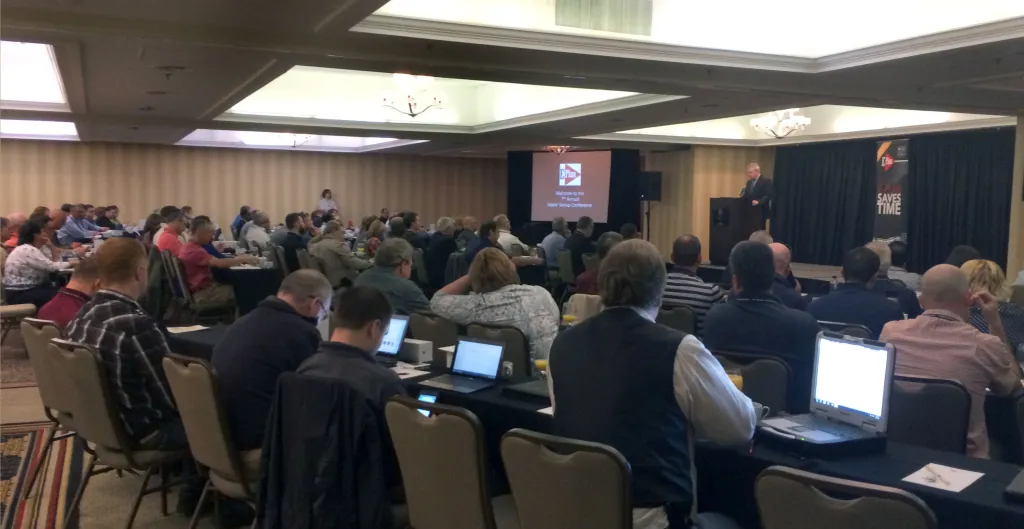7th Annual E-Plan Users Group Meeting held in North Carolina

The seventh annual E-Plan User’s Group Meeting was held in Raleigh, NC on November 4-5, 2015. The meeting, which garnered more than 130 people from nearly 15 states, including approximately fifty private industry attendees, twenty first-responders, and others from state and local emergency planning organizations.
The conference was organized by UT Dallas and Cutting Edge Planning & Training (CEPT). E-Plan, a system that researchers at UT Dallas built and currently maintain and manage, is the nation’s largest repository of facility and hazardous material information. The system provides first responders critical chemical information via web access on laptops and mobile devices and is in use in many communities nationwide.
Michael Sprayberry, Director of the Department of Emergency Management of the State of North Carolina, opened the meeting by welcoming guests to the conference and encouraging E-Plan users from both industry and government to exchange information and build on each other’s knowledge. Dr. Ron Bose, the Executive Director of the UT Dallas Institute for Data Analytics and Research Professor of Computer Science, joined him during his welcome address.

The first day of the conference consisted of a series of presentations by user states, about how E-Plan is utilized in their jurisdictions for emergency planning and by their first responders for saving lives. One of the presentations included a video made by the State of Montana (Click here to view video).
Dr. Duk-Jin Kim, Lead System Architect at the UT Dallas Institute for Data Analytics and a Ph.D. graduate of the UT Dallas CS program, presented enhancements and changes that E-Plan has undergone since the last E-Plan conference in 2014.
A senior official from the Intelligence Team of the Department of Homeland Security spoke of the importance of accurate tracking of storage and movement of hazardous chemicals. Jeff Suggs, an emergency management coordinator for the City of La Porte, TX delivered a talk entitled “Responding to a Chemical Incident”, which detailed a recent chemical accident that took place near Houston in 2014. He included in his talk the causes that led up to the event, responses to the incident, and future remediation plans.
Day two of the conference consisted of detailed training sessions for government and industry on the data in E-Plan – what it means, how to use E-Plan, and the correct steps regarding how to update it during the data renewal period of January-February each year. Matthew Marshall, Vice President of Cutting Edge Planning & Training, who is a certified trainer for E-Plan, conducted each session.
During the morning of the second day, the State of North Carolina also arranged for tours of their newly built $53-million State Emergency Operations Center in Raleigh. The center houses NC National Guard, the Division of Emergency Management and communications offices for the State Highway Patrol and the Department of Transportation, as well as a satellite office for the Governor of North Carolina.
E-Plan is the only nationwide Hazmat Emergency Management Information System that provides chemical facility incident pre-planning, management of hazardous chemical site information, and vulnerability analysis. It is used and endorsed by the EPA, DHS, Federal Emergency Management Agency (FEMA), urban search and rescue teams, and multiple Hazmat response entities nationwide in 45 states. The E-Plan database contains records for over 400,000 Tier II facilities in 36 states and 12,685 Risk Management Plan facilities in 50 states and four U.S. territories.
E-plan was developed by the UT Dallas Computer Science Department faculty and staff more than 10 years ago, and is currently maintained and managed by UT Dallas’ E-Plan Team located at the Institute for Data Analytics in the Erik Jonsson School. The Institute for Data Analytics was created to house and maintain projects that are now in production stage as well as to conduct applied and industrial research, especially, in the area of data analytics.
UT Dallas is recognized as one of the nation’s foremost service providers and system developers for hazardous chemical intelligence information and emergency management, preparedness, and response.
About the UT Dallas Computer Science Department
The UT Dallas Computer Science program is one of the largest Computer Science departments in the United States with over 1,600 bachelor’s-degree students, more than 1,100 master’s students, 160 PhD students, and 80 faculty members, as of Fall 2015. With The University of Texas at Dallas’ unique history of starting as a graduate institution first, the CS Department is built on a legacy of valuing innovative research and providing advanced training for software engineers and computer scientists.




